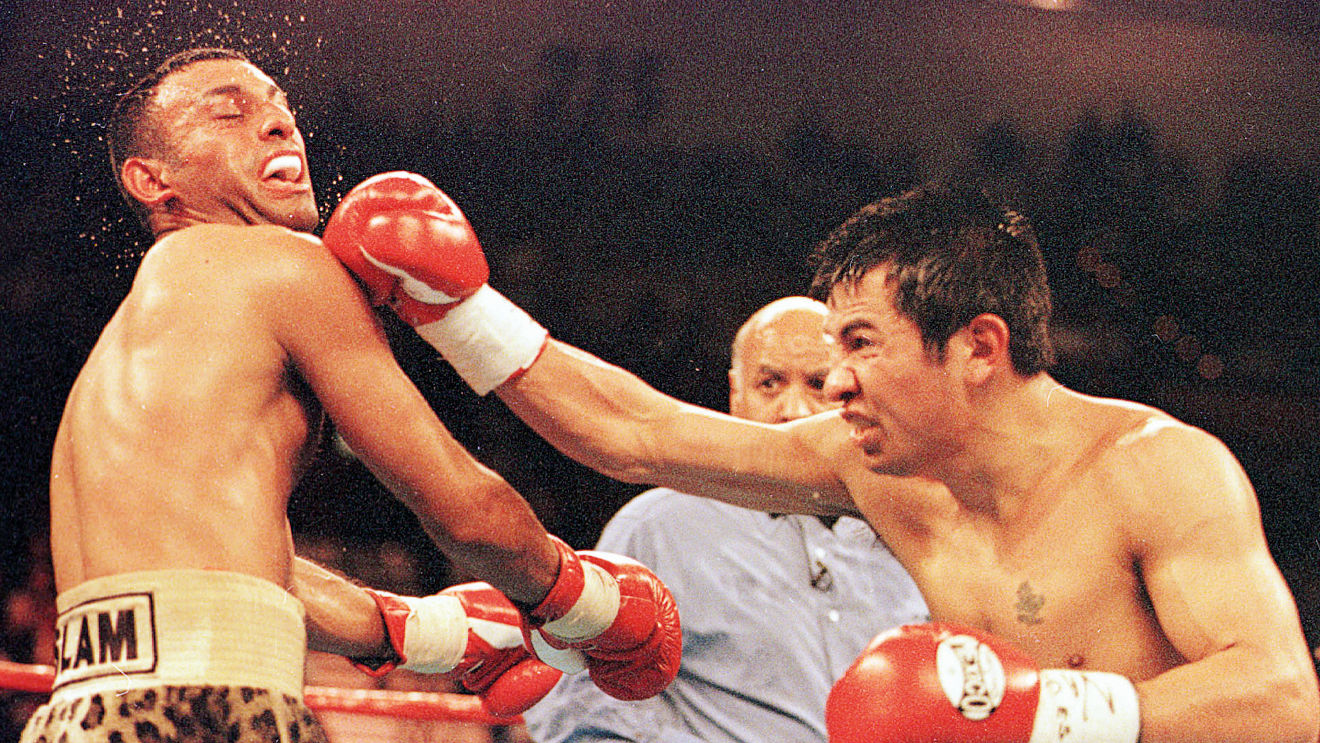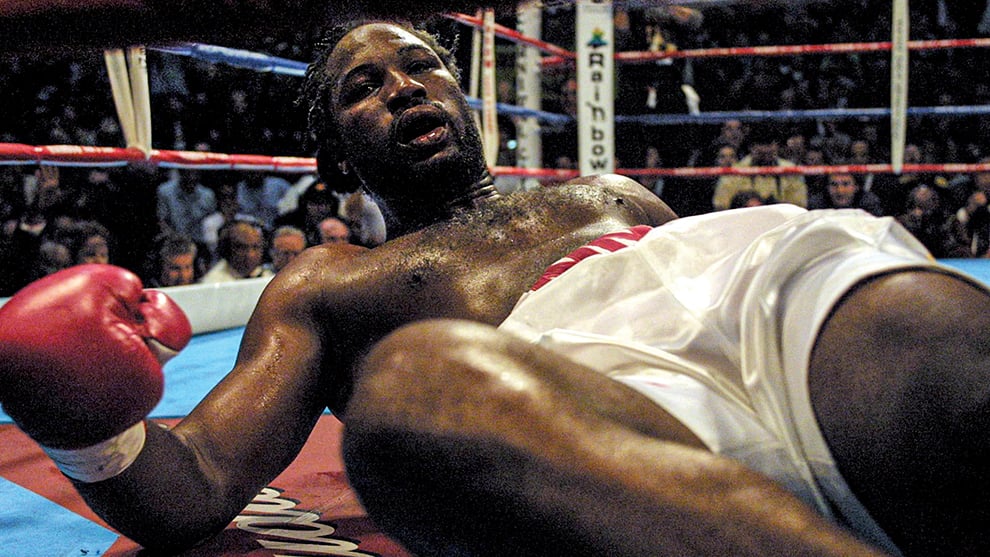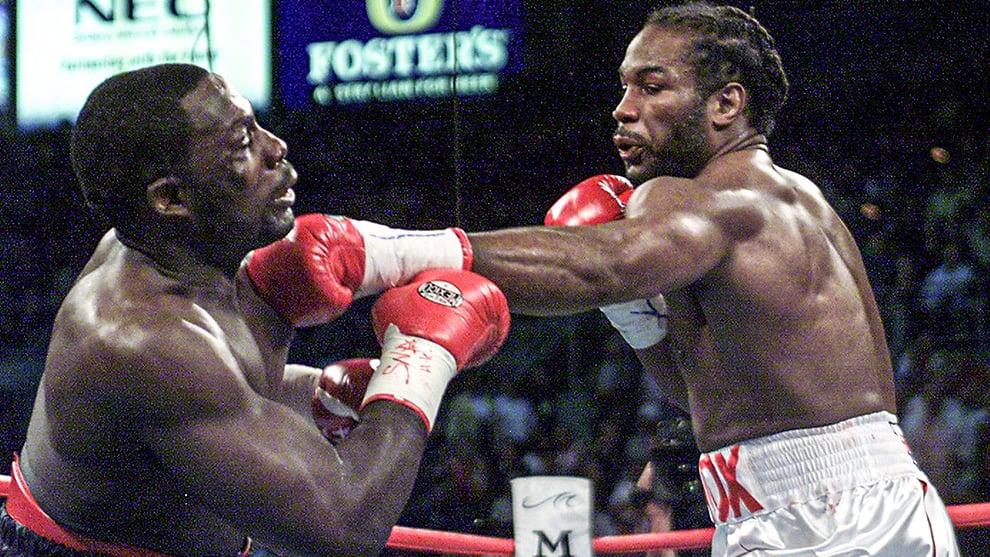By Elliot Worsell
In April 2001, it is safe to say that Great Britain proudly held the title of having the world’s top heavyweight and featherweight fighters, as well as two of the most renowned boxing stars, Lennox Lewis and ‘Prince’ Naseem Hamed.
During that time, Lewis held the titles of WBC and IBF heavyweight champion, while Hamed, although he gave up his WBO featherweight title, was widely acknowledged as the top fighter in the nine-stone division and potentially one of the most powerful punchers in his weight class.
Rarely do big names like them emerge in isolation, let alone together. However, they were also two men with targets on their backs. Unbeknownst to them, their fights scheduled for April would play a significant role in defining their legacies.
In Las Vegas on April 7, 2001, Hamed engaged in a bout against Marco Antonio Barrera, a former WBO super-bantamweight champion. Meanwhile, Lewis, two weeks later, defended his heavyweight titles in South Africa against the relatively unknown American boxer Hasim Rahman.
Spoiler one: In just two weeks, two British world champions would lose their titles, highlighting the unfortunate trend in British boxing where bad luck seems to come all at once.
Spoiler two: While one of the British boxing superstars would use this April setback as an opportunity for growth and success, the other would unfortunately crumble under the pressure.
Preparation
Hamed and Barrera: Talked about for some time, the meeting of ‘Prince’ Naseem Hamed and Marco Antonio Barrera was signed and set to take place, initially, on March 3, 2001. By then Hamed had decided to vacate the WBO featherweight title he had defended some 15 times and had done so to avoid having to fight his mandatory challenger, István Kovács, for considerably less money than he stood to receive fighting Barrera for the so-called ‘lineal’ championship. This made perfect sense at the time, as did Hamed’s decision to box Barrera, the reigning WBO super-bantamweight champion, a year after the Mexican had left behind bits of his body and soul during a thrilling 12-round war with Erik Morales.
Barrera, a 3-1 underdog, faced a formidable challenge in moving up in weight to take on Hamed. However, he saw the opportunity for a career-best payday (rumored to be $2 million compared to Hamed’s $6 million) and had confidence in his ability to endure Hamed’s power while capitalizing on perceived weaknesses in his defense.
By January, the proposed March 3 date had fallen apart and a new date of April 7 at the MGM Grand, Las Vegas had been arranged. Yet, even with extra time to get ready, Hamed’s preparation – chronicled by the painfully revealing documentary Little Prince, Big Fight – was questionable, suggestive of a man either utterly confident in his ability to destroy Barrera with one punch or, worse, a man so drunk on his own hype he had disregarded the possibility of losing altogether.
If this footage had been made public prior to the fight, it is possible that the odds, as well as Hamed’s attitude, might have been altered.
Lewis and Rahman: The year 2000 was so good to Lennox Lewis he would have been forgiven for thinking everything he touched turned to gold and that complacency was not something to fear but to instead consider both natural and expected.
Lewis, as the heavyweight champion, successfully defended his title three times that year by defeating Michael Grant, Frans Botha, and David Tua. He then set his sights on a highly lucrative match against Mike Tyson. The plan was for them to face off in the summer of 2001. However, this highly anticipated event had to be canceled when Tyson received a three-month suspension for testing positive for marijuana after his fight against Andrew Golota in 2000.
Lewis, who was all dressed up but had no destination, decided to explore other possibilities. Eventually, he made the choice to defend his title against Hasim Rahman from Baltimore on April 22, 2001. Although there were other offers available, such as a potential match with WBA heavyweight champion John Ruiz, Lewis was drawn to Rahman and the prospect of fighting in Brakpan, South Africa.
In the past, Rahman was considered an average heavyweight contender with two significant fights against David Tua and Oleg Maskaev resulting in knockout losses. Although he had three consecutive victories against Frankie Swindell, Corrie Sanders, and Marion Wilson before his chance at the title, Rahman was still deemed a 20-1 underdog against Lewis for valid reasons.
Despite the odds, ‘The Rock’ displayed unwavering determination. He made his way to Brakpan, a location situated 5,200 feet above sea level, on March 27. This was nearly a month prior to the fight, and more importantly, almost two weeks ahead of Lewis, who only arrived on April 10.
An oversight deemed irrelevant until proven otherwise, Lewis had done the bulk of his training in Las Vegas, Nevada, a location 2,000 feet above sea level, and did so because it allowed him to film scenes for a cameo appearance in the 2001 film Ocean’s Eleven. This was, while in Vegas, merely one of the perks of being the heavyweight champion of the world. It was not an issue until he was in South Africa and it became one.
Fight Night
Hamed and Barrera: A study in contrasting styles, Barrera was as compact as Hamed was loose and would wait for Hamed’s looseness to slip from dangerous to sloppy before landing the fight’s first key punch: a left hook. So dishevelled was Hamed, the shot had the Brit performing a dance, even if not hurt by it, and unquestionably set the tone. Hamed, in response, struck a pose, wiggled his hips and his shoulders, and smiled back at Barrera. He then took a jab in the face. Barrera, meanwhile, never altered his expression, rarely allowed either of his gloves to drop below his chin, and continued to edge forward, treating his own moments of success with a so-what? shrug.
Hamed’s impatience and desperation grew, causing his stance to widen and his shots to become even more unpredictable. This provided an opportunity for Barrera to successfully land jabs and hooks whenever Hamed was off balance. Lacking creativity, Hamed was solely focused on landing a knockout punch from the beginning of the fight. As each round passed, Barrera capitalized on Hamed’s mistakes and treated them as generous contributions, collecting them with appreciation.
Barrera not only outboxed Hamed in the final round but also took the opportunity to assert his dominance by forcefully slamming Hamed’s head into the ring post. This act served as a clear message, demonstrating that Barrera had not merely defeated Hamed but had thoroughly dominated him.
Barrera’s final-round transgression resulted in a deduction of points, but it did not significantly affect the scorecards which favored Barrera with scores of 115-112, 116-111, and 115-112. This outcome left Hamed with no choice but to acknowledge and applaud the superior skills of the Mexican master, as he was unable to inflict any damage on him. Hamed’s defeat not only ended his unbeaten record but also shattered his aura of invincibility.

During their match at the MGM Grand Garden Arena in Las Vegas, Nevada, Barrera successfully lands a punch on Hamed (Bello/ALLSPORT).
Lewis and Rahman: Forever comfortable when in control, Lewis could be seen during the pre-fight introductions asking his coach, Emanuel Steward, to ensure Rahman’s beltline was lowered before any punches were thrown. This message was then duly relayed to the referee, Daniel Van de Wiele, and Lewis got his wish; the first battle won.
Lewis, weighing 253 pounds and standing taller than his opponent, displayed his strong desire for control during the fight. He immediately took charge of the center of the ring, as if he held exclusive ownership. Meanwhile, Rahman, weighing 238 pounds, found himself circling on the outskirts, feeling uneasy but not intimidated. Lewis aimed to either displace the American with his left hand or deliver a jab.
Rahman, however, refused to be dominated and would occasionally evade, retreat, adjust his stance, and make his own attempts at shots, often in the form of jabs or bold right hands. While not all of these shots were successful, their purpose was to ensure Lewis remained alert and to earn his admiration. Rahman’s jab was strong and had great reach, while his right cross posed a threat. Yet, what truly stood out was Rahman’s remarkable composure.
“In round two,” commented HBO’s Larry Merchant, “Lewis’ mouth is already open, and I’m uncertain of its significance.” Although Rahman could consider reaching the next round a small triumph, Lewis emerged as the victor. However, in the third round, Rahman intensified his aggression despite losing, encouraged by Lewis’ low guard and his ability to withstand the champion’s powerful blows.
Rahman had a clever strategy to rely on Lewis becoming fatigued, and it paid off. As the fourth round progressed, Rahman assertively moved forward and successfully landed a solid right hand, causing the South African crowd to enthusiastically chant his name. Encouraged by the unexpected support and Lewis’ vulnerability, Rahman continued his assault in the fifth round, delivering two more powerful right hands. The first served as a cautionary gesture, while the second had far-reaching consequences, altering both the trajectory of heavyweight boxing and Rahman’s personal journey.
Despite the warning, Lewis ignored it and smiled just moments before the second one arrived.

Lewis, following his knockdown in the fifth round of his match against Hasim Rahman at the Carnival Arena in Brakpan, South Africa (AFP via Getty Images)
Aftermath
Hamed and Barrera: In the minutes and hours following his first professional loss, the word on both the street and in the ring centred on Hamed activating his rematch clause and getting revenge as soon as possible. Afterwards, Hamed himself said, “I want Barrera again and I’m going to knock him out,” and seemed, at best, confident and, at worst, sincere.
Nevertheless, the rematch clause, which required activation within two months after the fight’s conclusion, was completely overlooked. Consequently, Barrera was able to proceed and face Enrique Sánchez, leaving everyone puzzled.
After some time, Hamed finally revealed his intention to make a comeback in the boxing ring. He planned to compete in a European featherweight title fight against Manuel Calvo, a relatively unknown boxer from Spain, initially scheduled for March 23, 2002. However, the match was later rescheduled for May 18. When Hamed finally stepped into the ring again, over a year after his defeat against Barrera, he appeared sluggish and lacked inspiration. To make matters worse, his own fans at the London Arena booed him, expressing their disappointment. The atmosphere was filled with foot stomps, slow hand claps, and even chants of ‘Bruno! Bruno! Bruno!’ Clearly lacking motivation, Hamed managed to secure victory over Calvo through a decision after 12 rounds.
Hamed, the wealthiest featherweight boxer of all time, decided to retire from boxing, feeling a similar level of pain in victory as he had previously experienced in defeat.
Lewis and Rahman: Following his exploits in South Africa, HBO and Showtime both sweet-talked Rahman in an effort to secure exclusive rights to his next fight. There were rumours of Showtime offering him an estimated $19.25 million to face Mike Tyson in his first defence of the heavyweight titles and there were rumours of HBO offering him $17 million to face Lewis in a rematch.
Despite receiving two offers, Rahman declined both and opted for a $5 million contract with promoter Don King. Rather than accepting the offers, he agreed to face Brian Nielsen, a popular yet constrained Danish fighter, which could potentially bring him an extra $5 million.
Ultimately, it didn’t work out as planned, leaving Rahman without an opponent. However, this presented an opportunity for Lewis, who was eager to exercise his right to a rematch and sought revenge. Lewis took legal action to secure a second fight and eventually agreed to face Rahman on November 17, 2001, in Las Vegas. Driven by the desire to rectify past mistakes, Lewis was determined to set everything right this time.
It only took him less than four rounds to rid himself of his inner demons and bring Rahman, who had enjoyed a temporary reign, crashing to the ground with a powerful right hook. Lewis displayed unwavering focus, precision, and a strong desire to prove himself, surpassing not only his previous performance but possibly reaching the peak of his abilities on that memorable November evening.
Once Lewis had exacted his revenge, his final task was to finally meet Mike Tyson, which he accomplished in June 2002. Subsequently, he faced off against the formidable Vitali Klitschko, representing the new generation, in a match where he defended his WBC heavyweight title the following year. Despite being 37 years old and past his prime, Lewis demonstrated enough skill to prevent a bloodied and furious Klitschko from claiming his belt (the fight was stopped after six rounds due to cuts). This victorious outcome allowed Lewis to conclude his career on a high note.
Lewis left on an even higher note, proudly proclaiming that he had emerged victorious against every single opponent he encountered in his illustrious professional boxing career, a feat accomplished by only a select few.

Lewis lands a left on Rahman during the first round of their 2001 rematch
(Photo credit Jeff Haynes/AFP via Getty Images)
